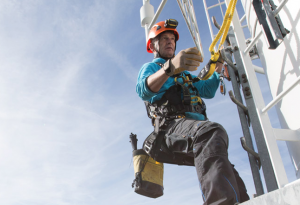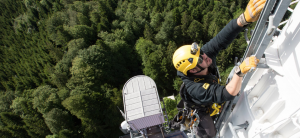INTRODUCTION TO ANSI STANDARDS
An American National Standard implies a consensus of those substantially concerned with its scope and provisions. An American National Standard is intended as a guide to aid the manufacturer, the consumer, and the general public. The existence of an American National Standard does not in any respect preclude anyone, whether they have approved the standard or not, from manufacturing, marketing, purchasing, or using products, processes, or procedures not conforming to the standard. American National Standards are subject to periodic review and users are cautioned to obtain the latest editions.
ANSI Z359.1 | The Fall Protection Code
The Fall Protection Code is a set of standards that covers program management; system design; training; qualification and testing; equipment, component and system specifications for the processes used to protect workers at height in a managed fall protection program. This standard identifies those standards and establishes their role in the Code and their interdependence.
The Fall Protection Code encompasses standards for personal fall protection systems that incorporate a full body harness, intended to protect the user against falls from a height either by preventing or arresting free falls. In general, systems that prevent a free fall are preferable to systems that arrest a free fall. The types of systems that shall be addressed by this Fall Protection Code include:
a) Fall restraint systems
b) Work positioning systems
c) Rope access systems
d) Fall arrest systems
e) Rescue systems
ANSI Z359.3 | Safety Requirements for Lanyards and Positioning Lanyards
This standard establishes requirements for the performance, design, marking, qualification and verification testing and instructions for lanyards and positioning lanyards for users within the capacity range of 130 to 310 pounds (59 to 140kg).
ANSI Z359.4 | Safety Requirements for Assisted-Rescue and Self-Rescue Systems, Subsystems and Components
This standard establishes requirements for the performance, design, marking, qualification, instruction, training, use, maintenance and removal from service of connectors, harnesses, lanyards, anchorage connectors, winches/hoists, descent control devices, rope tackle blocks and self-retracting lanyards with integral rescue capability comprising rescue systems, utilized in pre-planned self-rescue and assisted-rescue applications for one to two persons.
ANSI Z359.11 | Safety Requirements for Fully Body Harnesses
This standard establishes requirements for the performance, design, marking,qualification, instruction, training, test methods, inspection, use, maintenance and removal from service of full body harnesses (FBH). FBHs are used for fall arrest, positioning, travel restraint, suspension and/or rescue applications for users within the capacity range of 130 to 310 pounds (59 to 140 kg).
ANSI Z359.12 | Connecting Components for Personal Fall Arrest Systems
This standard establishes requirements for the performance, design, marking, qualification, test methods and removal from service of connectors. This standard addresses only components that are used in the interconnection of a complete unit, intended to be used as a primary single link to a permanent anchorage connector, and/or intended to be used as a primary attachment point.
ANSI Z359.13 | Personal Energy Absorbers and Energy Absorbing Lanyards
This standard establishes requirements for the performance, design criteria, marking, qualification, and verification testing, instructions, inspections, maintenance and removal from service of personal energy absorbers and energy absorbing lanyards for users within the capacity range of 130 to 310 pounds (59 – 140 kg.). This standard is for use by organizations where employees are exposed to fall hazards.
 ANSI Z359.15 | Safety Requirements for Single Anchor Lifelines and Fall Arresters for Personal Fall Arrest Systems
ANSI Z359.15 | Safety Requirements for Single Anchor Lifelines and Fall Arresters for Personal Fall Arrest Systems
This standard establishes requirements for the design criteria, qualification testing (performance requirements), marking and instructions, user inspections, maintenance and storage and removal from service of single anchor lifelines and fall arresters for users within the capacity range of 130 to 310 pounds (59 to 140kg).
ANSI Z87.1-2010 | Occupational and Educational Personal Eye and Face Protective Devices
This standard sets forth criteria related to the general requirements, testing, permanent marking, selection, care, and use of protectors to minimize the occurrence and severity or prevention of injuries from such hazards as impact, non-ionizing radiation and chemical exposures in occupational and educational environments including, but not limited to, machinery operations, material welding and cutting, chemical handling, and assembly operations. Certain hazardous exposures are not covered in this standard. These include, but are not limited to: blood-borne pathogens, X-rays, high-energy particulate radiation, microwaves, radio-frequency radiation, lasers, masers, and sports and recreation.
ANSI Z89.1-2009 | Industrial Head Protection
This standard describes Types and Classes, testing and performance requirements for protective helmets. These include recommended safety requirements for authorities considering the establishment of regulations or codes concerning the use of protective helmets.
ANSI Z107 | High-Visibility Safety Apparel and Headwear
This standard speci es performance requirements for high visibility safety apparel and headwear PPE. For the purpose of this standard, the term “garment” shall be used to mean apparel and headwear PPE. These garments are intended to provide conspicuity to the user in hazardous situations under any light conditions by day and under illumination by vehicle headlights in the dark. Performance requirements are included for color, retro reflection, and minimum areas, as well as the recommended configuration of the materials. Performance requirements are also provided for the physical properties of background materials used in the construction of high-visibility safety apparel and headwear. Test methods are provided in the standard to help ensure that a minimum level of visibility is maintained when garments are subjected to ongoing care procedures.
